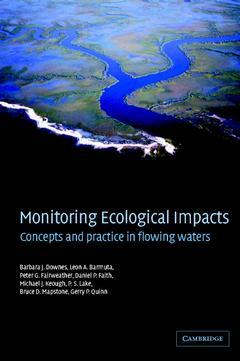Description
Monitoring Ecological Impacts
Concepts and Practice in Flowing Waters
Authors: Downes Barbara J., Barmuta Leon A., Fairweather Peter G., Faith Daniel P., Keough Michael J., Lake P. S., Mapstone Bruce D., Quinn Gerry P.
Provides clear and useable protocols for the detection and measurement of human impacts on the environment.
Language: English
Subject for Monitoring Ecological Impacts:
Approximative price 149.32 €
Subject to availability at the publisher.
Add to cart
Monitoring ecological impacts concepts and practice in flowing waters
Publication date: 01-2002
452 p. · 15.7x23.7 cm · Hardback
Publication date: 01-2002
452 p. · 15.7x23.7 cm · Hardback
68.67 €
Subject to availability at the publisher.
Add to cart
Monitoring ecological impacts: concepts and practice in flowing waters
Publication date: 06-2008
452 p. · 15.2x23 cm · Paperback
Publication date: 06-2008
452 p. · 15.2x23 cm · Paperback
Description
/li>Contents
/li>Biography
/li>
Monitoring Ecological Impacts provides the tools needed by professional ecologists, scientists, engineers, planners and managers to design assessment programs that can reliably monitor, detect and allow management of human impacts on the natural environment. The procedures described are well grounded in inferential logic, and the statistical models needed to analyse complex data are given. Step-by-step guidelines and flow diagrams provide the reader with clear and useable protocols, which can be applied in any region of the world and to a wide range of human impacts. In addition, real examples are used to show how the theory can be put into practice. Although the context of this book is flowing water environments, especially rivers and streams, the advice for designing assessment programs can be applied to any ecosystem.
Part I. Introduction to the Nature of Monitoring Problems and to Rivers: 1. Why we need well-designed monitoring programs; 2. The ecological nature of flowing waters; 3. Assessment of perturbation; Part II. Principles of Inference and Design: 4. Inferential issues for monitoring; 5. The logical bases of monitoring design; 6. Problems in applying designs; 7. Alternative models for impact assessment; Part III. Applying Principles of Inference and Design: 8. Applying monitoring designs to flowing waters; 9. Inferential uncertainty and multiple lines of evidence; 10. Variables that are used for monitoring in flowing waters; 11. Defining important changes; 12. Decisions and trade-offs; 13. Optimization; 14. The special case of monitoring attempts at restoration; 15. What's next?
Barbara J. Downes is a Senior Lecturer in Ecology in the Department of Geography and Environmental Studies at the University of Melbourne, Australia. She is an aquatic ecologist, with 20 years research experience in both freshwater and marine environments.
Leon A. Barmuta is a Lecturer in Zoology at the University of Tasmania, Australia. He is a freshwater ecologist with extensive experience in basic and applied ecology in Australia and the United States of America.
Peter Fairweather is a Senior Lecturer in Ecology at Deakin University, Australia. He has worked in marine, estuarine and freshwater ecosystems in Australia and USA, and has edited the Australian Journal of Ecology.
Daniel Faith is a Principal Research Scientist at the Australian Museum, with research interests in systematics, biodiversity conservation and biological monitoring. He is an Associate Editor of Systematic Biology.
Michael Keough is a Reader in Zoology at the University of Melbourne. His research interests include the ecology of natural and human-induced disturbances in coastal habitats. He is co-author of Experimental Design and Data Analysis for Biologists, Cambridge University Press, 2002.
P. S. Lake is Professor in Ecology at Monash University, Australia. He is currently Chief Ecologist in the Cooperative Research Centre for Freshwater Ecology.
Leon A. Barmuta is a Lecturer in Zoology at the University of Tasmania, Australia. He is a freshwater ecologist with extensive experience in basic and applied ecology in Australia and the United States of America.
Peter Fairweather is a Senior Lecturer in Ecology at Deakin University, Australia. He has worked in marine, estuarine and freshwater ecosystems in Australia and USA, and has edited the Australian Journal of Ecology.
Daniel Faith is a Principal Research Scientist at the Australian Museum, with research interests in systematics, biodiversity conservation and biological monitoring. He is an Associate Editor of Systematic Biology.
Michael Keough is a Reader in Zoology at the University of Melbourne. His research interests include the ecology of natural and human-induced disturbances in coastal habitats. He is co-author of Experimental Design and Data Analysis for Biologists, Cambridge University Press, 2002.
P. S. Lake is Professor in Ecology at Monash University, Australia. He is currently Chief Ecologist in the Cooperative Research Centre for Freshwater Ecology.
© 2024 LAVOISIER S.A.S.




